November 27, 2025 | 10:02 GMT +7
November 27, 2025 | 10:02 GMT +7
Hotline: 0913.378.918
November 27, 2025 | 10:02 GMT +7
Hotline: 0913.378.918
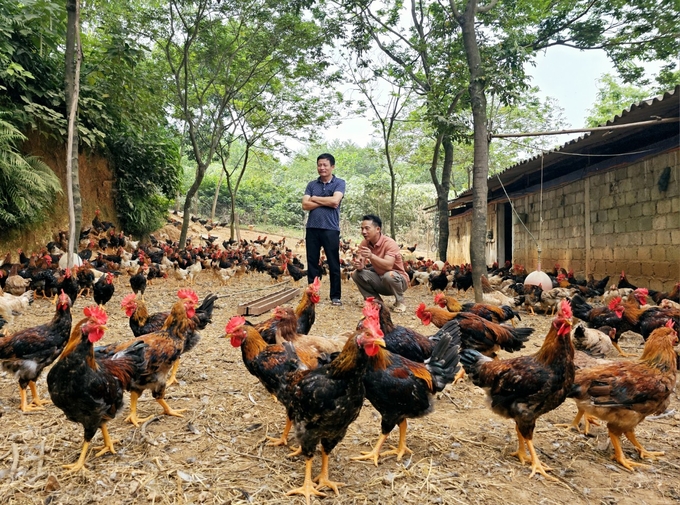
A biosafety livestock production revolution is happening in Vinh Phuc. Photo: Hoang Anh.
Finding strengths in tourism and agricultural development, many years ago, chicken farming has become a spearhead economy in many localities in Tam Dao district. Phung Thi Vi, Head of Tam Dao District Office of Livestock Production and Animal Health, called Tam Quan commune the "heart" of livestock farming in this district.
If the entire Tam Dao district regularly maintains a total herd of 1.6 - 1.7 million chickens, Tam Quan alone has 1.3 - 1.4 million chickens every year. Statistics show that the entire commune has approximately 1,700 chicken farming households, which includes more than 150 farm-scale models. Particularly in recent years, thanks to well-implement biosafety livestock farming measures, chicken farmers of Tam Dao district in general and Tam Quan commune in particular are no longer afraid of disease.

Tam Quan commune is famous for its chicken farming industry. Photo: Hoang Anh.
There was a time when almost everyone in Tam Quan commune raised chickens, from small-scale farms and cooperatives to establishing production and processing linkages with large corporations. Talking about chicken farming in Vinh Phuc province meant talking about Tam Quan commune and vice versa.
For a long time, chicken farming was spontaneous without any attention to quality control of breeds, feed, and vaccines, so livestock farmers in Tam Quan commune were struggling because of epidemics. Many families even went bankrupt because of chickens. However, from 2015 onward, thanks to changing mindsets and applying new farming solutions specifically biosafety processes, many families in Tam Quan have turned their lives around and become billionaires.
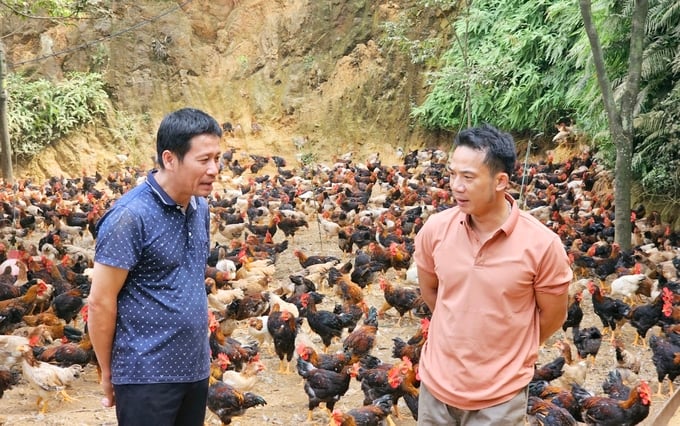
Nguyen Duy Hien (right), owner of the largest chicken farm in Lang Ma village. Photo: Hoang Anh.
During the peak period, the 1,000 m2 barn of the family of Nguyen Duy Hien and Nguyen Thi Thanh Loan in Lang Ma village (Tam Quan commune) raises 13,000 - 15,000 chickens. In recent years, Hien's family has raised approximately 25,000 chickens per year on average.
Due to the impact of high animal feed prices and low chicken prices, from the beginning of the year to the end of August, Hien's family lost VND 15-20 million each month, but chicken prices are currently VND 70,000 - 90,000/kg depending on the type, so the family is expecting a profit of VND 40 - 50 million /1,000 chickens. If there is no problem from now until Tet, Hien's chicken farm can make VND 500 - 700 million in profit.
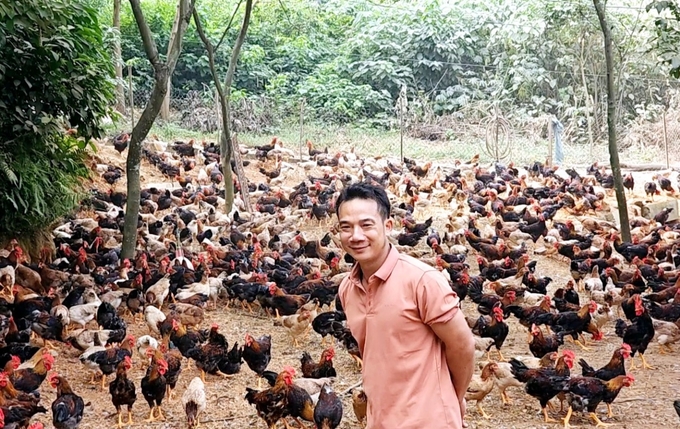
"Chicken farming’s main concerns at the moment are input and output prices. We do not need to worry about diseases because the people pay great attention to biosafety farming measures," said Hien. Photo: Hoang Anh.
Being a bold and dynamic farmer, Hien pioneers in converting to the biosafety chicken farming model in Tam Quan commune. On their hilly land, the couple invested and built two closed barns, with automatic feeding and drinking troughs plus a cooling system.
The family has certain ways to minimize risks and maintain high incomes. The first solution is vaccination. Hien's family normally vaccinates the batch of chickens while following the recommendations of the local veterinary officer. The next step is to clean the barn and disinfect livestock areas, transportation vehicles, food, drinking water, etc.
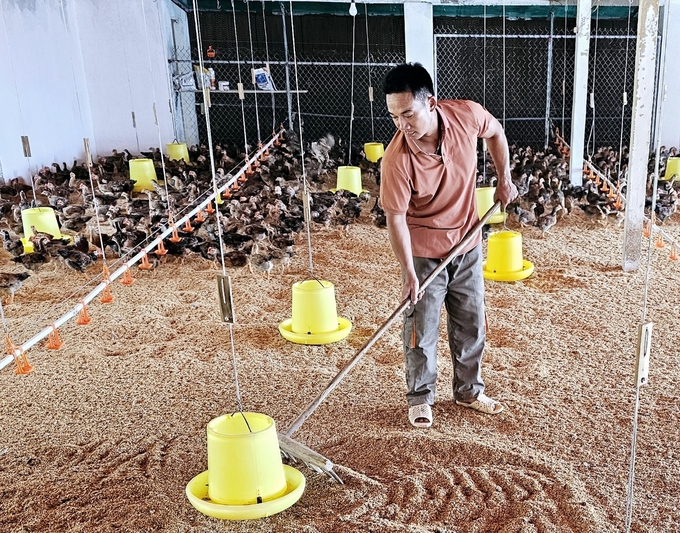
Hien is also the first person in Tam Quan commune to use microbial products as bedding to handle environmental problems. Photo: Hoang Anh.
Tran Van Diep, Tam Quan Commune Office of Livestock Production and Animal Health, said, ”Now almost all farming models with a scale of 1,000 chickens or more use biosafety farming methods and use microbial products as bedding. This is the basis for Tam Quan the “chicken capital” to aim for sustainable chicken production chain and build the “Tam Dao Chicken” brand.
Vinh Phuc province and Tam Dao district have support policies for livestock households to register for VietGAP and OCOP certification, establishing cooperatives and cooperative groups to increase value for livestock farmers in the area. Chicken farming in Tam Quan commune is experiencing a transition in both scale and quality.
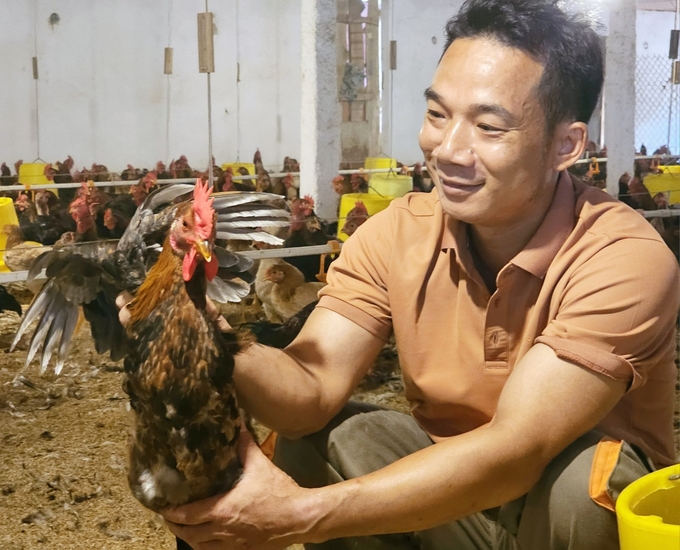
Tam Dao commune aspires to build the “Tam Dao Chicken” brand. Photo: Hoang Anh.
Le Xuan Cong, Director of Vinh Phuc Department of Livestock Production and Animal Health, said that Vinh Phuc’s livestock development scheme for the period 2022 - 2025 identifies 3 main types of livestock: cows, pigs and chickens, and the total chicken herd has now exceeded 12.5 million, guaranteeing the set target.
As a result, the province’s main objective is not to expand the herd but instead focus on biosafety measures, addressing environmental issues while improving economic efficiency in local farming models.
Implementing the plan of Vinh Phuc People's Committee on reducing environmental pollution in livestock farming by using biological products in the 2021 - 2023 period, the provincial agricultural sector has supported 50% of the cost of purchasing biological products to make bedding and treating chicken waste. “Biosafety chicken farming models have proven its economical, environmental and social efficiency. This is surely the direction of Vinh Phuc’s animal husbandry industry in the years to come,” said Le Xuan Cong.
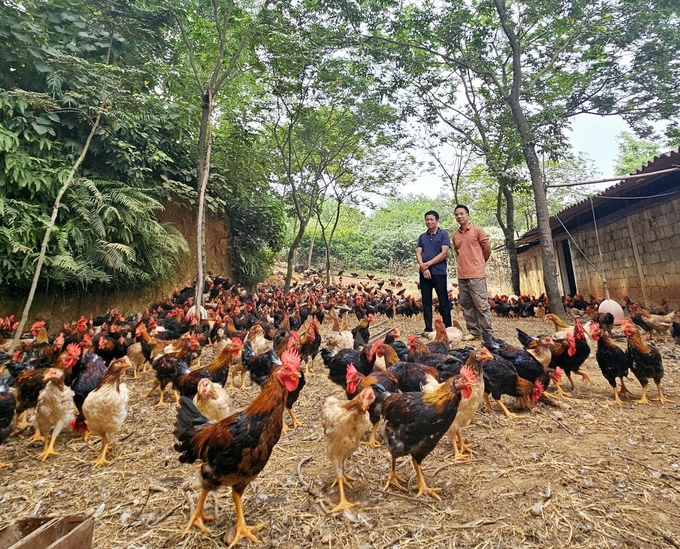
Vinh Phuc aims for a sustainable direction in chicken farming. Photo: Hoang Anh.
The most obvious effect of biosafety livestock farming is that it solves environmental inadequacies caused by livestock farming activities. The support program to reduce environmental pollution in livestock farming by using biological products has helped organizations and individuals become more aware of ensuring hygiene in animal husbandry.
Translated by Samuel Pham
/2025/11/26/4909-2-154329_878.jpg)
(VAN) Pearl grouper farming in HDPE cages not only delivers economic efficiency but also contributes to protecting the environment, creating jobs, and promoting marine-based experiential tourism.

(VAN) The model of making a living under the forest canopy through the agroforestry system in Van Son commune, Bac Ninh province, is expected to generate an annual income of approximately VND 30 million/ha.

(VAN) Many enterprises in Can Tho are harnessing natural energy and reducing greenhouse gas emissions in their production processes, thereby contributing to the promotion of a sustainable green transition.
/2025/11/24/3536-2-112800_176.jpg)
(VAN) Dong Nai now has tens of thousands of hectares of forests certified for sustainable management, and this area will continue to be expanded in the coming period.

(VAN) Vinh Ha hamlet (Dai Xuyen commune, Hanoi) is shifting away from small-scale farming as households adopt bioscurity into their breeder chicken models.

(VAN) Heavy rains make aquatic species more vulnerable to disease. Proactive water management and high-tech systems help farmers prevent outbreaks and protect yields.

(VAN) Greenhouses are shifting production mindsets in Binh Lu commune, enabling farmers to ‘weather the sun and rain’ and secure stable vegetable harvests throughout the year.